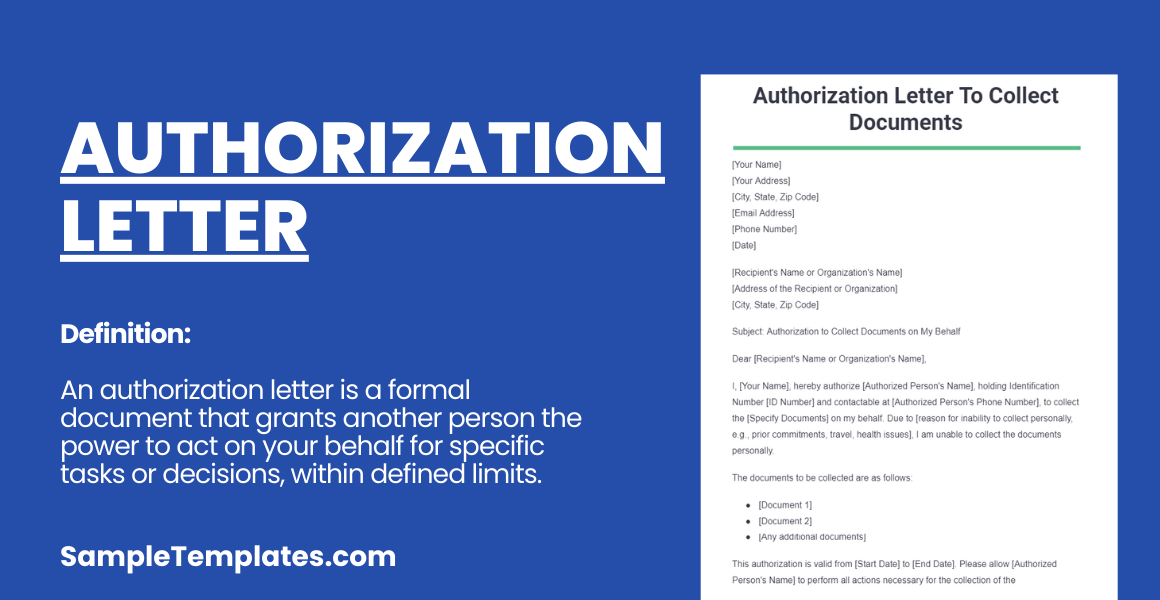In business communication, there is a legal importance of the Authorization letter format. It has to be very precise and accurate to give the authority to the third party. It actually gives the permission to the third party to act on behalf of us. They are widely used to give authorization power to the Lawyers to act on behalf of the client or the accountant to handle the financial matters.
Example Of Authorization Letter
To facilitate you to draft a professional authorization letter outline, we have collected and designed some of the unique letters for you to download. They are mainly downloadable in PDF, DOC and PDS Formats.
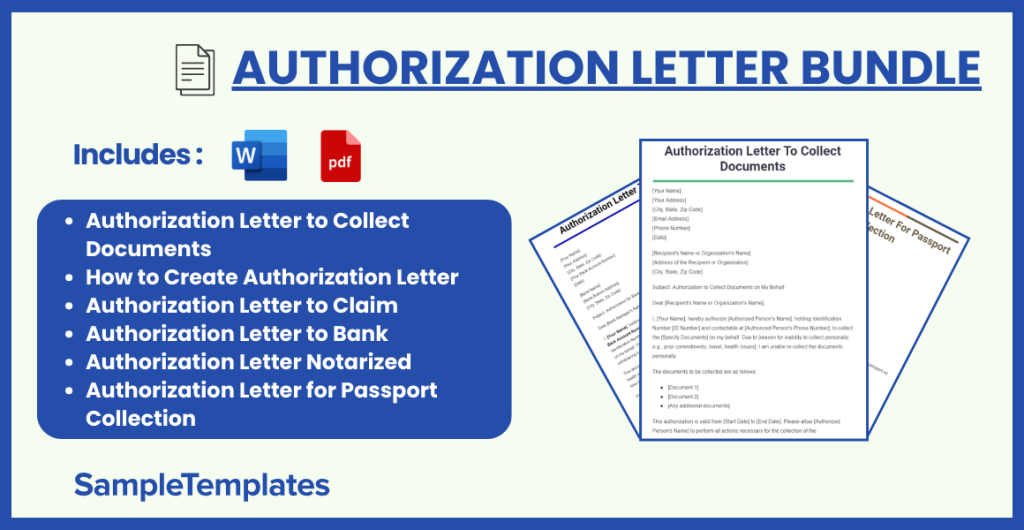
Download Authorization Letter Bundle
Authorization Letter to Collect Documents
[Your Name]
[Your Address]
[City, State, Zip Code]
[Email Address]
[Phone Number]
[Date]
[Recipient’s Name or Organization’s Name]
[Address of the Recipient or Organization]
[City, State, Zip Code]
Subject: Authorization to Collect Documents on My Behalf
Dear [Recipient’s Name or Organization’s Name],
I, [Your Name], hereby authorize [Authorized Person’s Name], holding Identification Number [ID Number] and contactable at [Authorized Person’s Phone Number], to collect the [Specify Documents] on my behalf. Due to [reason for inability to collect personally, e.g., prior commitments, travel, health issues], I am unable to collect the documents personally.
The documents to be collected are as follows:
- [Document 1]
- [Document 2]
- [Any additional documents]
This authorization is valid from [Start Date] to [End Date]. Please allow [Authorized Person’s Name] to perform all actions necessary for the collection of the aforementioned documents. I trust that all documents will be handled with care and confidentiality.
Attached is a copy of my identification [Specify ID type, e.g., Driver’s License, Passport] and [Authorized Person’s Name]’s identification for verification purposes.
Should you require any further information or clarification, please do not hesitate to contact me at [Your Phone Number] or [Your Email Address].
Thank you for your assistance and cooperation in this matter.
Sincerely,
[Your Signature]
[Your Printed Name]
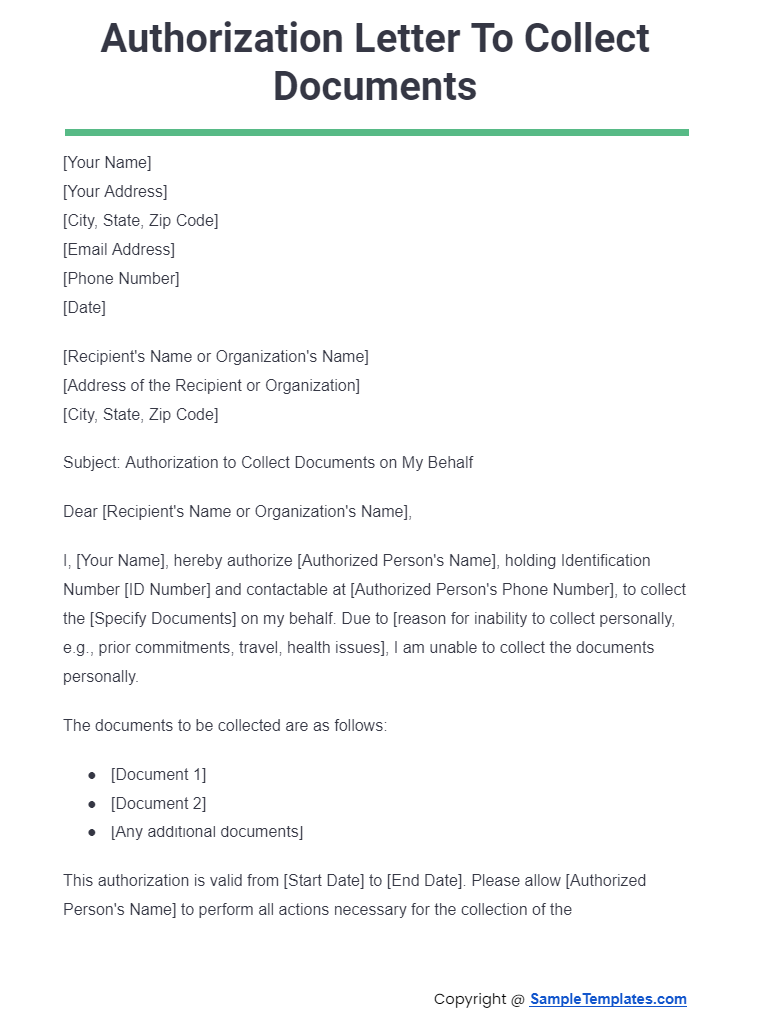
Download In
How to Create Authorization Letter
Creating an authorization letter involves drafting a formal document that grants permission to another individual or entity to perform specific actions on your behalf. Here’s a step-by-step guide to writing an effective authorization letter:
Step 1: Start with Your Information
Begin your letter by typing your full name, address, and contact information (phone number and email address) at the top left corner of the page. This establishes your identity as the authorizing party.
Step 2: Add the Date
Directly below your contact information, write the current date to indicate when the letter was written. This is important for the validity and timeliness of the authorization.
Step 3: Include the Recipient’s Details
Proceed by adding the name, title (if applicable), and address of the individual or organization to whom the letter is addressed. If you are unsure of the specific recipient, a general title such as “To Whom It May Concern” may be used, but specific names are preferable for clarity and effectiveness.
Step 4: Write a Subject Line
A clear subject line, such as “Authorization to Act on My Behalf,” succinctly informs the reader of the letter’s purpose. Place this below the recipient’s details.
Step 5: Craft a Salutation
Begin the body of your letter with a formal salutation, using “Dear [Recipient’s Name or Title],” to address the reader respectfully.
Step 6: State the Purpose of the Letter
In the first paragraph, clearly state your purpose for writing the letter. Mention your full name again and explicitly express that you are granting authorization to another party. Specify the name and any identifying information of the individual you are authorizing.
Step 7: Detail the Authorization
Clearly describe the specific actions or decisions the authorized person can make on your behalf. Include any relevant details such as account numbers, document types, or transaction details. Specify any limitations or conditions to this authorization to prevent misuse.
Step 8: Mention the Validity Period
Indicate the start and end dates of the authorization period to ensure there is no confusion about the timeframe within which the authorized actions are permitted.
Step 9: Offer Additional Instructions (Optional)
If there are specific instructions or conditions associated with the authorization, outline them clearly in a separate paragraph. This might include instructions for verifying the authorized person’s identity or how to handle certain tasks.
Step 10: Close with a Formal Conclusion
Conclude your letter with a statement of appreciation for the recipient’s cooperation, followed by a formal closing, such as “Sincerely” or “Best Regards,” and your signature. Below your signature, print your name for clarity.
Step 11: Attach Identification (Optional)
For added security and verification, you may attach copies of your identification and that of the authorized individual. Note in the letter that you have included these attachments.
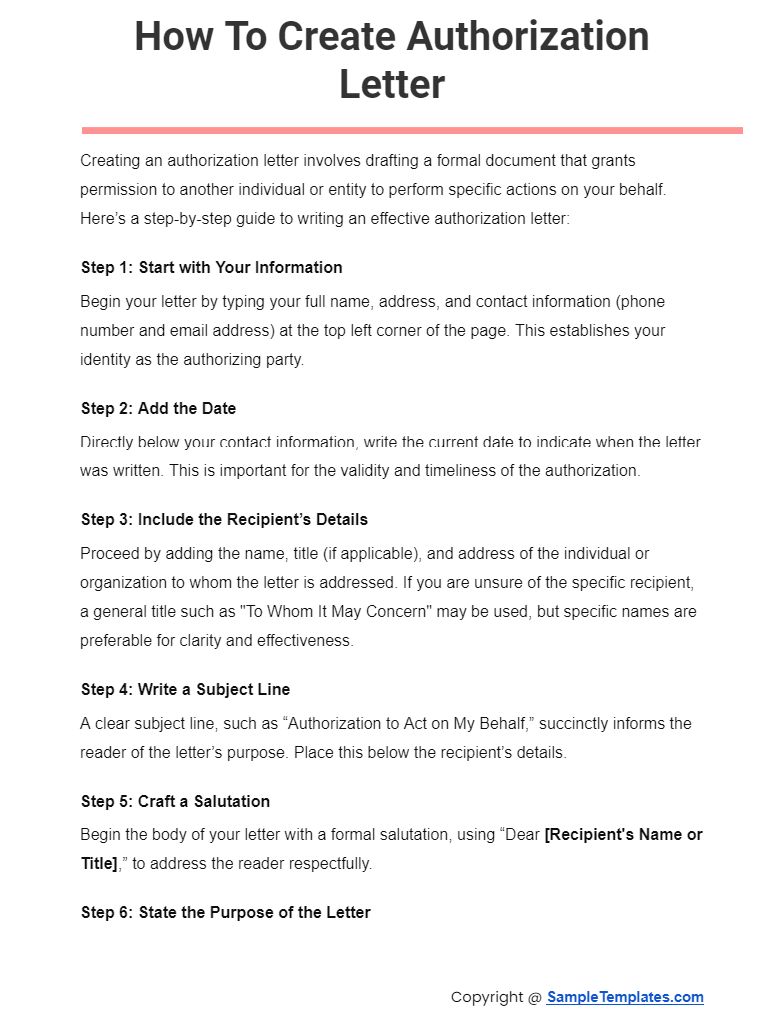
Download In
Authorization Letter to Claim
[Your Name]
[Your Address]
[City, State, Zip Code]
[Email Address]
[Phone Number]
[Date]
[Recipient’s Name or Organization’s Name]
[Recipient’s Address]
[City, State, Zip Code]
Subject: Authorization Letter to Claim [Specify Item or Document]
Dear [Recipient’s Name or Organization’s Name],
I, [Your Name], hereby authorize [Authorized Person’s Name], to claim [Specify the item or document, e.g., passport, package, diploma] on my behalf. Due to [reason for your inability to claim personally, e.g., conflicting commitments, travel, health reasons], I am unable to collect it in person.
[Authorized Person’s Name] has my permission to act in all matters related to the claiming of the aforementioned item. For identification purposes, [Authorized Person’s Name] will present their [type of identification, e.g., driver’s license, passport] with number [ID number], along with a copy of this authorization letter.
This authorization is valid from [Start Date] until [End Date], if applicable.
Please extend all courtesies to [Authorized Person’s Name] in completing this process. Should you require any further information or verification from my side, do not hesitate to contact me at [Your Phone Number] or [Your Email Address].
Thank you for your cooperation and understanding in this matter.
Sincerely,
[Your Signature]
[Your Printed Name]
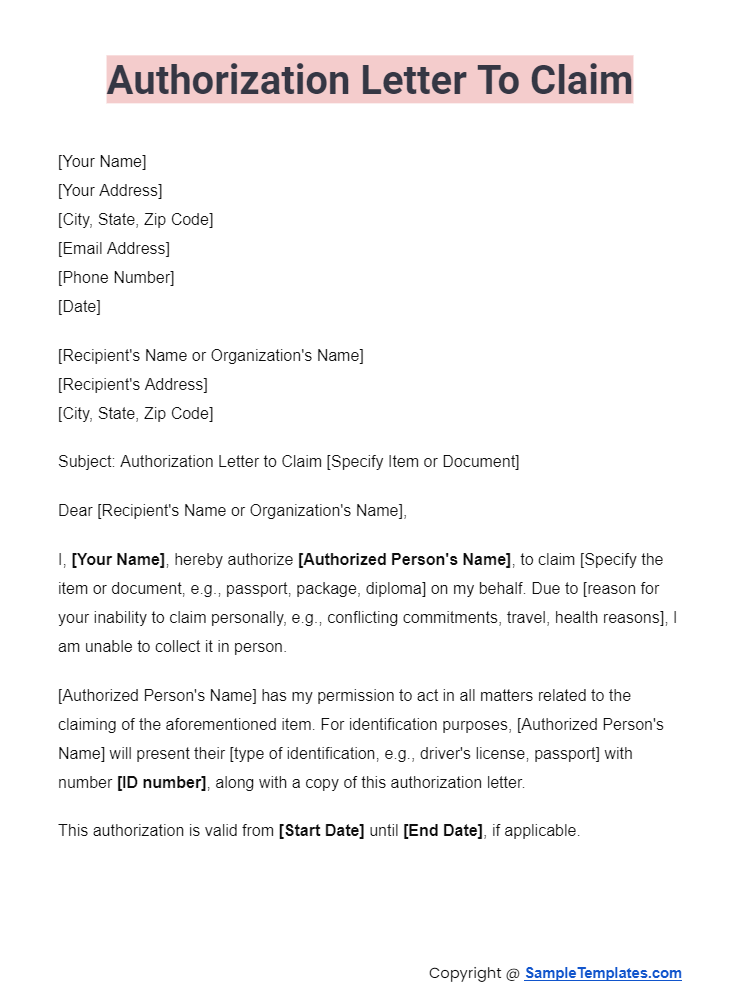
Download In
Authorization Letter to Bank
[Your Name]
[Your Address]
[City, State, Zip Code]
[Your Bank Account Number]
[Date]
[Bank Name]
[Bank Branch Address]
[City, State, Zip Code]
Subject: Authorization for Banking Transactions
Dear [Bank Manager’s Name or Bank’s Name],
I, [Your Name], holding an account with your bank under the account number [Your Bank Account Number], hereby authorize [Authorized Person’s Name], bearing Identification Number [Authorized Person’s ID Number], to conduct banking transactions on my behalf. This authorization includes but is not limited to, making deposits, withdrawing funds, and inquiring about account balances.
This decision comes due to [briefly state the reason, e.g., my current travel abroad, health issues, etc.], which prevents me from managing these activities personally for the time being.
Please find attached a photocopy of my identification (ID type: [Your ID Type], ID number: [Your ID Number]) along with [Authorized Person’s Name]’s identification for your records and verification purposes.
This authorization is effective from [Start Date] and will remain in effect until [End Date], unless explicitly revoked in writing by me prior to this date.
I trust that [Authorized Person’s Name] will handle the banking transactions with the utmost responsibility, and I assure you that any actions taken by them on my behalf are with my full consent.
I appreciate your bank’s cooperation in facilitating this process and ensuring the continuation of smooth transactions regarding my account during my absence.
Should you require any further clarification or additional documentation, please feel free to contact me at [Your Phone Number] or [Your Email Address].
Thank you for your attention to this matter.
Sincerely,
[Your Signature]
[Your Printed Name]
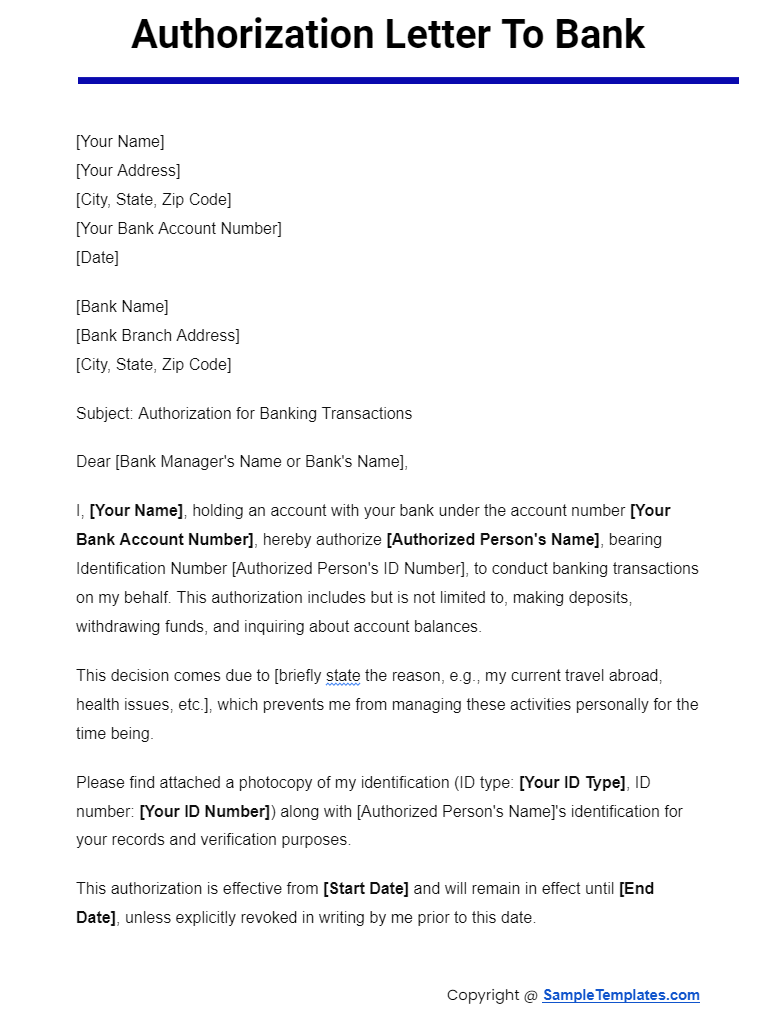
Download In
Authorization Letter Notarized
[Your Name]
[Your Address]
[City, State, Zip Code]
[Email Address]
[Phone Number]
[Date]
[Notary Public’s Name or Notary Service Name]
[Office Address]
[City, State, Zip Code]
Subject: Request for Document Notarization
Dear [Notary Public’s Name or Title],
I, [Your Name], hereby request your services to notarize a document on my behalf. The document in question is [describe the document, e.g., a Power of Attorney, a Property Deed, a Contract], which is essential for [briefly state the purpose, e.g., legal proceedings, property transfer, official transactions].
Due to [mention any specific reason if applicable, e.g., scheduling conflicts, physical inability to appear in person], I am unable to present the document for notarization in person. Therefore, I am sending [Authorized Person’s Name], who has been given full authority to act on my behalf for the purpose of notarizing this document.
For identification and verification purposes, [Authorized Person’s Name] will present their [type of identification, e.g., driver’s license, passport], ID number [ID number], along with this authorization letter. Please ensure that the document is handled with confidentiality and that the notarization process is completed as per the legal requirements.
This authorization is valid for the date of [specific date or range of dates during which notarization can occur], after which it should be considered null and void.
I trust that your services will be performed with the utmost professionalism and accuracy. Attached are copies of my identification and the document to be notarized for your reference. Should you require any further information or documentation, please do not hesitate to contact me at [Your Phone Number] or [Your Email Address].
Thank you for your attention to this matter and for facilitating this process. I look forward to your confirmation of the appointment for notarization.
Sincerely,
[Your Signature]
[Your Printed Name]
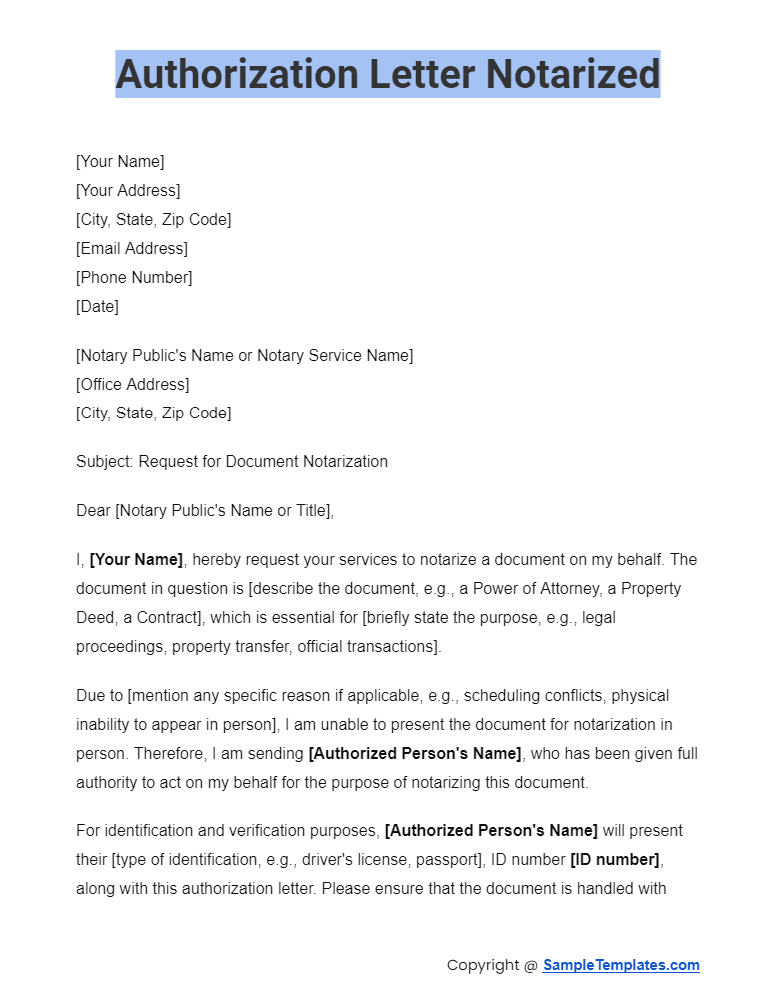
Authorization Letter for Passport Collection
[Your Name]
[Your Address]
[City, State, Zip Code]
[Email Address]
[Phone Number]
[Date]
[Embassy or Consulate Name]
[Passport Collection Office Address]
[City, State, Zip Code]
Subject: Authorization for Passport Collection
Dear Sir/Madam,
I, [Your Name], hereby authorize [Authorized Person’s Name], to collect my passport on my behalf from your esteemed office. My passport details are as follows:
- Passport Number: [Your Passport Number]
- Date of Issue: [Issue Date]
- Date of Expiry: [Expiry Date]
Due to [reason for your inability to collect the passport personally, e.g., travel commitments, health reasons], I am unable to collect my passport in person. Therefore, I have granted [Authorized Person’s Name] the authority to collect it on my behalf.
[Authorized Person’s Name] will present their identification ([type of identification, e.g., driver’s license, passport]) with the number [ID number] for verification purposes. Please find attached a photocopy of my identification (ID type: [Your ID Type], ID number: [Your ID Number]) and [Authorized Person’s Name]’s identification for your records.
I request that the passport be handed over to [Authorized Person’s Name] upon presentation of this letter and the necessary identification documents. I trust that all personal information will be handled with confidentiality and care.
Should you require any further information or clarification, please do not hesitate to contact me at [Your Phone Number] or [Your Email Address].
Thank you for your assistance and understanding in this matter.
Sincerely,
[Your Signature]
[Your Printed Name]
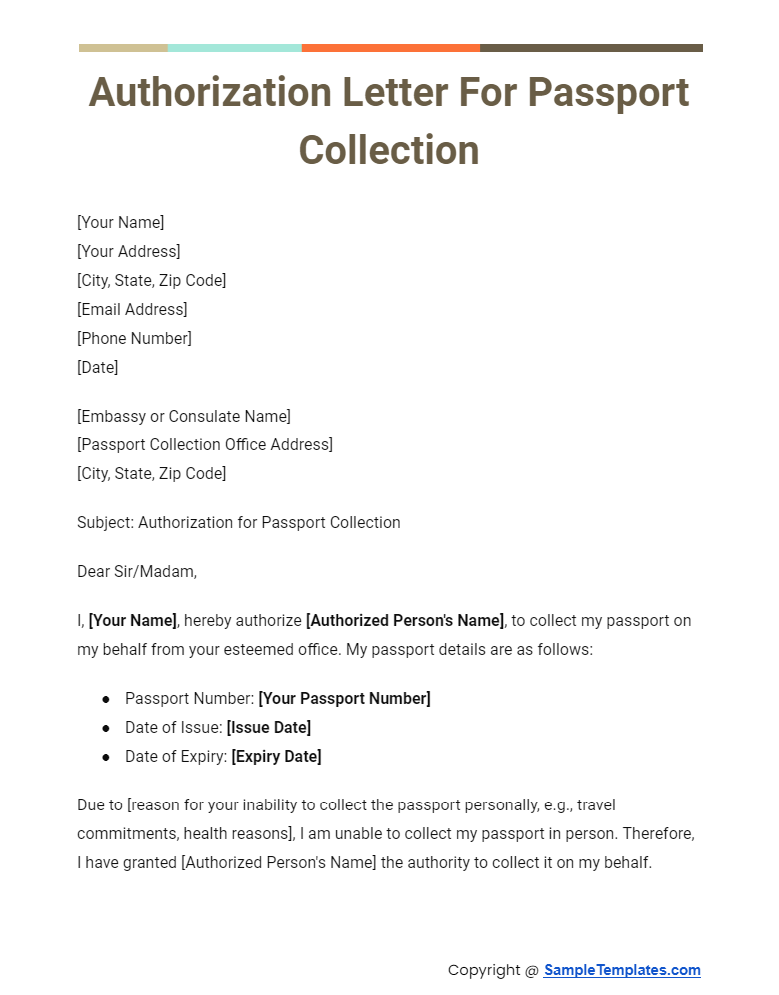
Download In
Browse More Templates on Authorization Letter
1. Authorization Letter
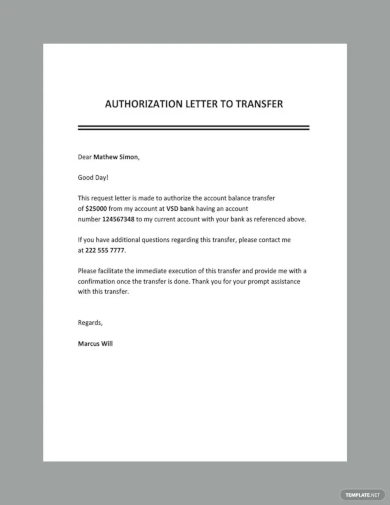
Key Elements of an Authorization Letter
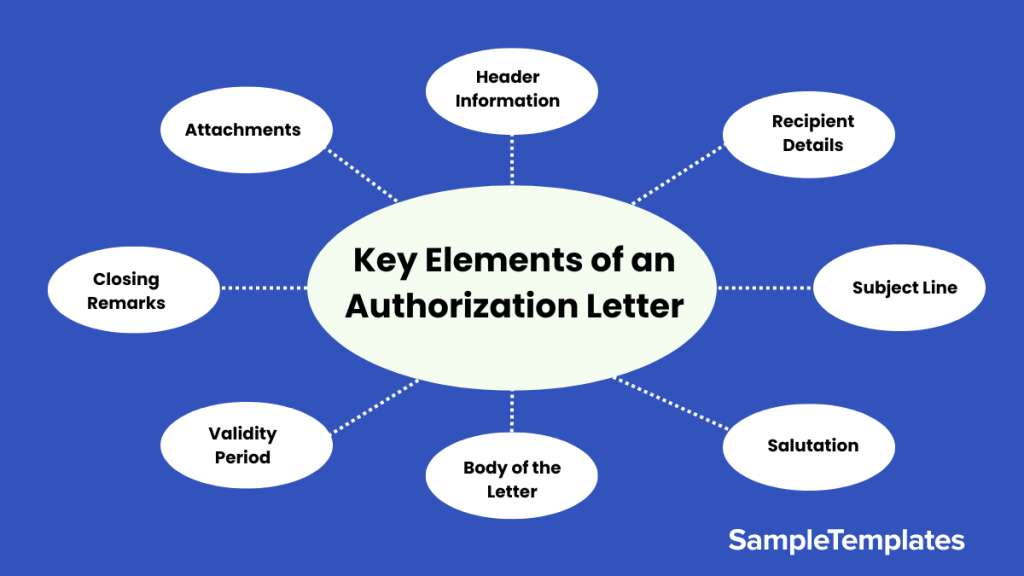
- Header Information: Includes the sender’s name, address, contact details, and the date the letter is written.
- Recipient Details: The name, address, and possibly the title of the individual or organization receiving the letter.
- Subject Line: A concise statement clearly indicating the letter’s purpose, such as “Authorization Letter for Document Collection.”
- Salutation: A formal greeting to the recipient, using their name or a general title if the name is unknown.
- Body of the Letter:
- Introduction: Brief statement of the letter’s purpose, identifying the authorizer and the essence of the authorization.
- Authorized Agent’s Information: Details of the person being authorized, including full name and identification details for verification.
- Scope and Limitations: Clear description of the specific actions or decisions the authorized person can make, including any restrictions.
- Validity Period: The time frame during which the authorization is effective, specifying start and end dates if applicable.
- Closing Remarks: A polite conclusion, expressing gratitude or anticipation of cooperation, followed by the authorizer’s signature and printed name.
- Attachments (if any): Mention of any accompanying documents, such as identification proofs, that support the authorization process.
2. Authorization Letter Sample

3. Authorization Letter Format in Word

4. Example of Authorization Letter
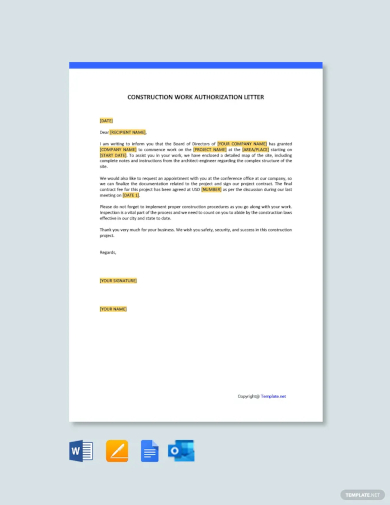
Types of Authorization Letter
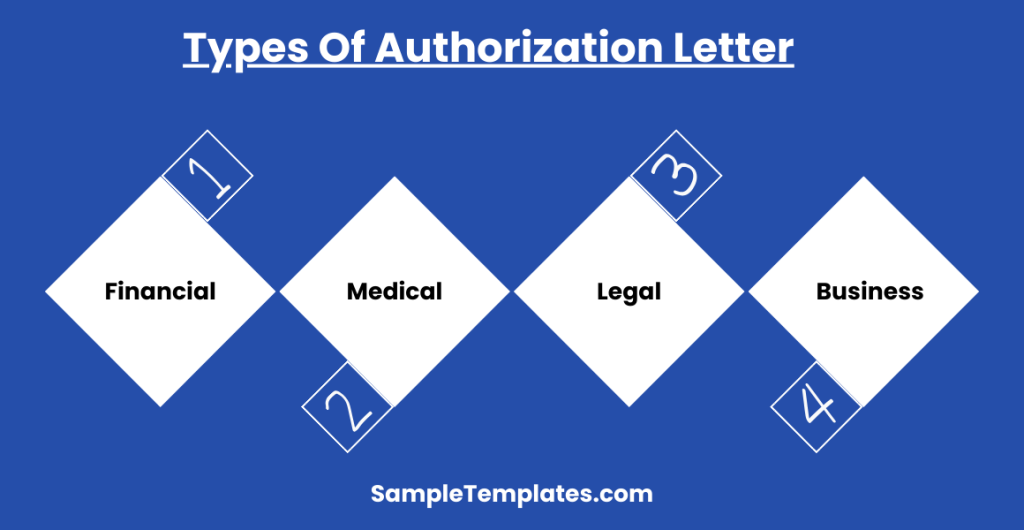
Authorization letters can be categorized based on their purpose and the specific permissions they grant. Here are some common types:
- Financial Authorization Letter: Grants a designated individual the authority to handle financial transactions on behalf of the authorizer, such as banking operations, withdrawing money, and making investment decisions.
- Medical Authorization Letter: Allows a specified person to make medical decisions or access medical records on behalf of the authorizer, often used for minors or individuals under medical care.
- Legal Authorization Letter: Provides someone the power to act on legal matters, such as attending court hearings, signing legal documents, or handling estate matters on behalf of the authorizer.
- Business Authorization Letter: Empowers an individual to make business-related decisions, manage transactions, or represent the authorizer in business meetings and negotiations.
- Travel Authorization Letter: Used by parents or guardians to grant permission for minors to travel with an appointed adult, specifying travel dates, destinations, and other relevant details.
- Collection of Documents Authorization Letter: Authorizes someone to collect documents, such as passports, diplomas, official records, or mail, on the authorizer’s behalf.
- Vehicle Authorization Letter: Allows an individual to use or manage the authorizer’s vehicle, including dealing with registration processes, insurance matters, or even selling the vehicle.
- Property Authorization Letter: Grants permission to manage or make decisions regarding the authorizer’s property, including leasing, selling, or maintaining it.
5. Authorization Letter Editable
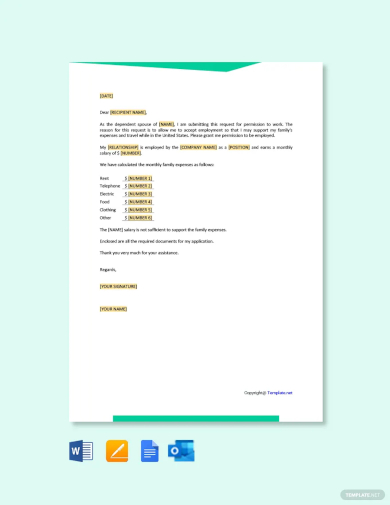
6. Sample Authorization Letter to Process
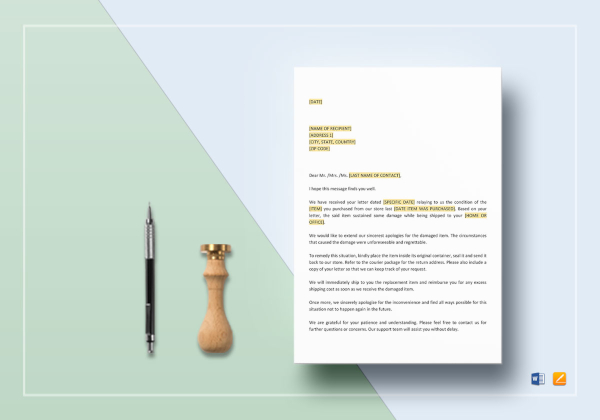
What is an Authorisation Letter?
An authorization letter is a formal document that grants someone the authority to act on behalf of another person or entity. It is often used in various situations where the person granting the authority (the “principal”) cannot be present or involved in a particular matter and needs to delegate specific powers or responsibilities to someone else (the “agent” or “proxy”). Authorization letters are legally binding and serve as a written record of the delegation of authority.
Here are the key elements and purposes of an authorization letter:
1. Authorization: The letter explicitly states the authority or powers being granted. This can include actions like signing documents, making decisions, accessing financial accounts, collecting documents, or any other specific tasks.
2. Parties Involved: An authorization letter typically identifies both the principal (the person giving the authority) and the agent (the person receiving the authority). Their names and contact details are mentioned in the letter.
3. Reason for Authorization: The letter provides a clear and concise explanation of why the authority is being granted. This could be due to absence, inability, or a need for someone else’s expertise in a particular matter.
4. Duration of Authorization: The letter specifies the period for which the authorization is valid. It can be a one-time authorization or ongoing for a specified period.
5. Signature: The principal signs the letter to indicate their consent and approval of the authorization. In some cases, the letter may need to be notarized or witnessed for added legal validity.
6. Verification Documents: Depending on the nature of the authorization, the letter may include sample references to any relevant documents or identification that the agent should carry to prove their authority.
7. Legal Clarity: Authorization letters should be clear and unambiguous in their language to avoid misunderstandings. They should state the exact scope of authority and any limitations.
Common situations where authorization letters are used include:
- Authorization for a minor: Parents may use authorization letters to grant temporary guardianship or permission to travel for their children.
- Financial Matters: Authorization can be given to someone to access a bank account, manage investments, or conduct financial transactions on behalf of the account holder.
- Medical Treatment: In cases where a person is unable to make medical decisions, they may authorize someone to make healthcare choices on their behalf.
- Business Transactions: Businesses may use authorization letters for their employees or representatives to sign contracts, collect payments, or perform other business-related tasks.
- Legal Proceedings: Authorization letters may be used in legal matters to appoint an attorney or agent to act on someone’s behalf.
- Travel: When someone is unable to travel, they can authorize another person to pick up tickets, visas, or handle travel-related tasks.
- Collecting Documents: Authorization can be granted to collect documents from government offices, educational institutions, or other authorities.
Authorization letters are versatile tools that ensure that essential matters can proceed even when the principal cannot be present. It’s important to draft them carefully, considering the specific situation and legal requirements, to avoid any potential issues or disputes.
7. Authorization Letter PD>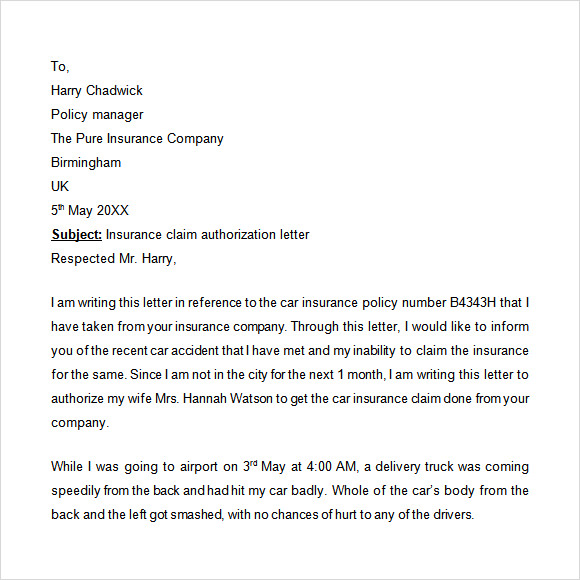

How do you write an authorization letter?
Writing an letter of authorization involves a specific format and set of details to ensure clarity and legality. Here’s a step-by-step guide on how to write an authorization letter:
Step 1: Format and Layout
- Use a formal business letter format. Place your name and address at the top, followed by the date.
- Include the recipient’s name, title, and address below your details.
- Add a salutation, such as “Dear [Recipient’s Name],”
- Use a professional and polite tone throughout the letter.
Step 2: State Your Intent
- Begin the letter by clearly stating your intent to authorize someone. For example, “I am writing to authorize [Name of Authorized Person] to [Specify the action or task they are authorized for].”
Step 3: Provide Details
- In the body of the letter, provide specific details related to the authorization, including the following:
- Recipient’s Identity: Mention the full name of the person you are authorizing.
- Scope of Authorization: Clearly specify what the authorized person is allowed to do. Be precise in describing the actions, responsibilities, or decisions they are empowered to make.
- Timeframe: If the authorization has a limited duration, mention the start and end dates.
- Exceptions: Mention any limitations or exceptions to the authorization if applicable.
Step 4: Justify the Authorization
- Explain why the authorization is necessary or what circumstances led to it. This helps provide context to the recipient.
Step 5: Signature and Contact Information
- Sign the letter by hand in ink. Include your full name beneath your signature.
- Provide your contact information, including phone number and email, so the recipient can reach you for clarification if needed.
Step 6: Notarization (If Required)
- In some cases, you may need to get the letter notarized to confirm its authenticity. Check whether this is necessary for your specific situation.
Step 7: Close the Letter
- Use a polite closing, such as “Sincerely,” followed by your name.
Step 8: Copies and Distribution
- Make copies of the letter for your records and the authorized person.
- Send the original letter to the recipient or organization that requires the authorization.
8. Authorization Letter Download
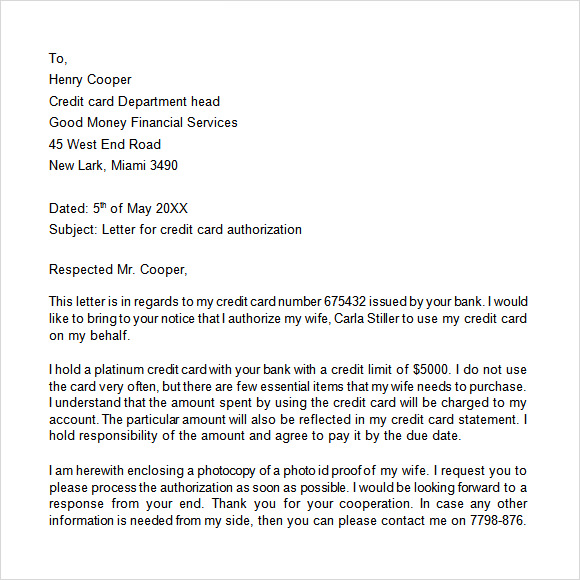
9. Authorization Letter Sample Editable
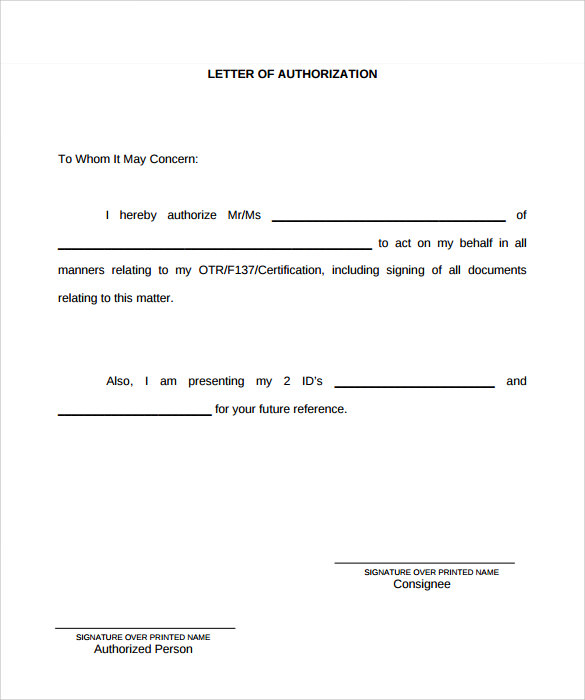
Common Mistakes to Avoid When Writing an Authorization Letter
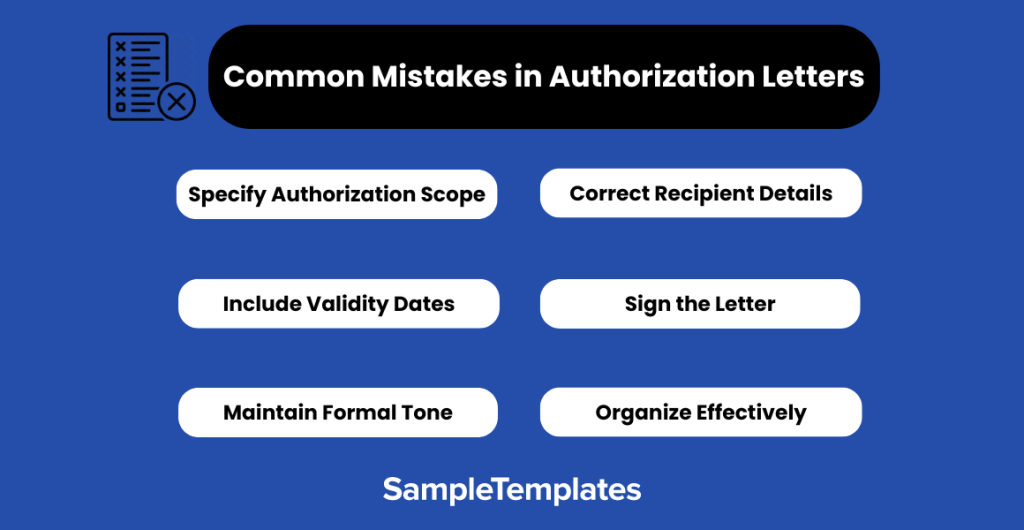
- Specify Authorization Scope: Clearly define permissions and limitations to avoid confusion.
- Include Validity Dates: State the start and end dates of the authorization to prevent ambiguities.
- Identify Authorized Person: Provide detailed identification of the authorized individual for service access.
- Correct Recipient Details: Ensure accurate recipient information for effective delivery and action.
- Maintain Formal Tone: Use professional language to emphasize the letter’s seriousness.
- Sign the Letter: Validate the authorization with your signature for legal standing.
- Provide Contact Information: Include your contact details for any necessary clarifications.
- Organize Effectively: Present information logically with a clear structure for reader comprehension.
10. Authorization Letter Format Download
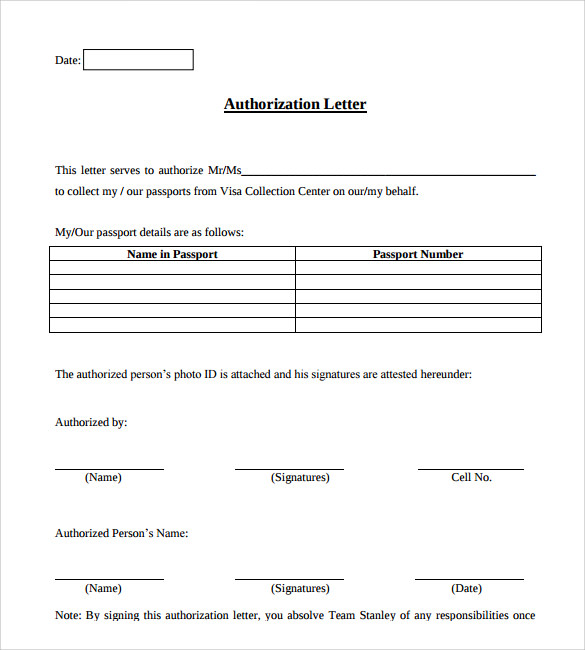
Who provides letter of authorization?
A letter of authorization can be provided by an individual or an organization, depending on the context and the specific permissions or actions being authorized. Here are some common scenarios in which different entities provide letters of authorization:
- Individuals to Individuals: Individuals may provide letters of authorization to authorize someone else to act on their behalf in various personal or legal matters. For example, you might provide a letter of authorization to a family member to collect a document from a government office in your absence.
- Individuals to Organizations: Individuals may provide letters of authorization to authorize organizations to perform specific actions on their behalf. For instance, you might provide a letter of authorization to your bank to allow a family member to access your account.
- Organizations to Individuals: Organizations, such as companies or institutions, can issue letters of authorization to individuals to grant them specific privileges or access. This can include permissions to enter restricted areas, attend events, or represent the organization in certain capacities.
- Organizations to Organizations: Companies or institutions can provide letters of authorization to other organizations or business partners. This often occurs in the context of business agreements, contracts, or collaborations, where one entity authorizes the other to perform certain tasks or actions.
- Government Agencies: Government agencies may issue letters of authorization to individuals or organizations for various purpose statement. For example, a government agency might provide a letter of authorization to an individual or organization to carry out specific activities, such as conducting research on public land.
- Legal and Financial Institutions: Legal and financial institutions, like law firms and banks, often issue letters of authorization as part of their services. These letters can be used to grant legal representation authority or financial power of attorney.
- Notaries Public: Notaries public are authorized to create notarized letters of authorization. These notarized documents carry legal weight and are often used in situations where the authenticity of the authorization is crucial, such as in real estate transactions.
The entity or individual providing the letter of authorization should ensure that the document is drafted accurately, following the legal and procedural requirements of the relevant jurisdiction. In some cases, notarization may be necessary to confirm the authenticity of the authorization. It’s essential to seek legal advice or guidance when creating or interpreting letters of authorization in complex or legally significant situations.
11. Authorization Letter Sample Download
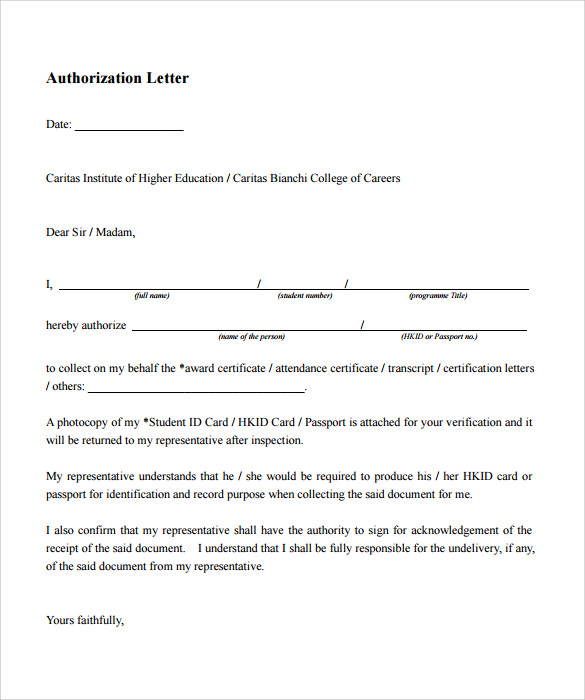
12. Authorization Letter Sample to Claim Documents
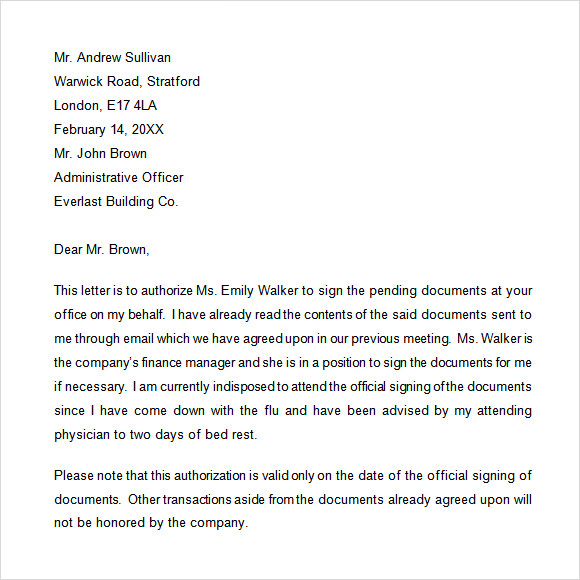
Importance of a Letter of Authorization
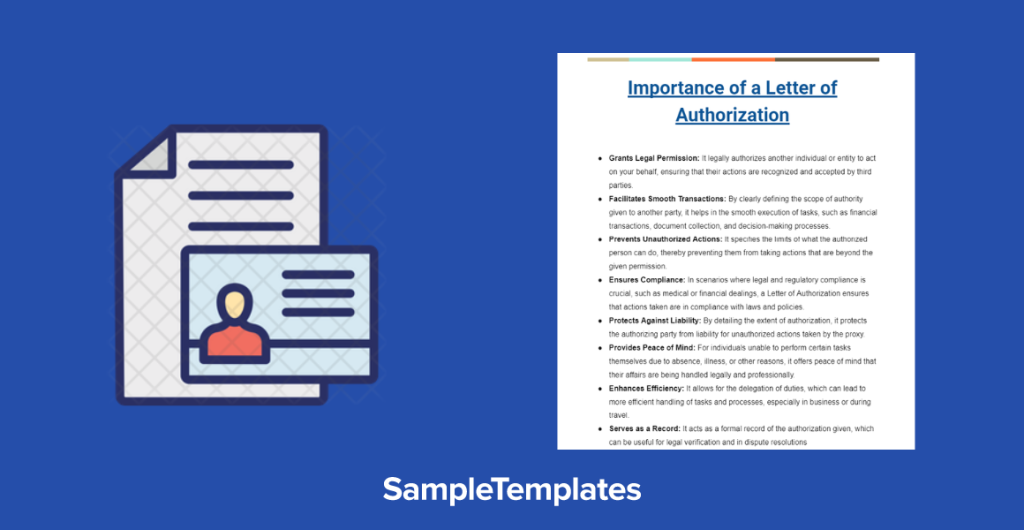
- Grants Legal Permission: It legally authorizes another individual or entity to act on your behalf, ensuring that their actions are recognized and accepted by third parties.
- Facilitates Smooth Transactions: By clearly defining the scope of authority given to another party, it helps in the smooth execution of tasks, such as financial transactions, document collection, and decision-making processes.
- Prevents Unauthorized Actions: It specifies the limits of what the authorized person can do, thereby preventing them from taking actions that are beyond the given permission.
- Ensures Compliance: In scenarios where legal and regulatory compliance is crucial, such as medical or financial dealings, a Letter of Authorization ensures that actions taken are in compliance with laws and policies.
- Protects Against Liability: By detailing the extent of authorization, it protects the authorizing party from liability for unauthorized actions taken by the proxy.
- Provides Peace of Mind: For individuals unable to perform certain tasks themselves due to absence, illness, or other reasons, it offers peace of mind that their affairs are being handled legally and professionally.
- Enhances Efficiency: It allows for the delegation of duties, which can lead to more efficient handling of tasks and processes, especially in business or during travel.
- Serves as a Record: It acts as a formal record of the authorization given, which can be useful for legal verification and in dispute resolutions.
13. Simple Authorization Letter
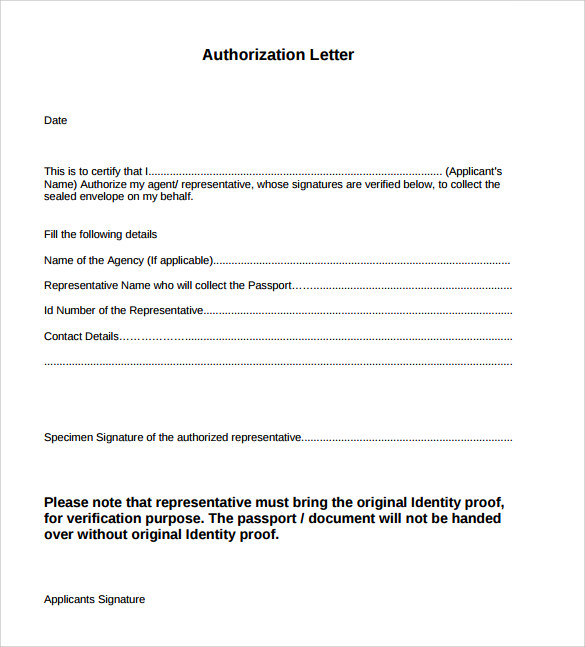
Does Authorization Letter Have a Signature?
Yes, an authorization letter typically includes the signature of the person granting the sample authorization, known as the “principal.” The principal’s signature confirms their consent and authenticity.
Who Provides Letter of Authorization?
A letter of authorization can be provided by various entities, including individuals, companies, government agencies, and organizations. The entity or individual issuing the letter of authorization has the legal authority to grant specific permissions or delegate authority as specified in the document.
How to Write Authorization Letter?
- Use a formal business letter format.
- Include your contact information.
- Address the recipient appropriately.
- State the purpose and scope of authorization clearly.
- Include details of the authorized person.
- Sign the letter and have it notarized if necessary.
What is a Letter of Authorisation on Behalf of Someone?
A letter of authorization on behalf of someone is a written document where one person, known as the principal, grants another person, known as the agent or representative, the legal authority to act on their behalf in specific matters or transactions. It allows the agent to make decisions, sign documents, or take actions as if they were the principal. This type of letter is commonly used in various situations, including legal, financial, medical, or business matters, where the principal may not be physically present or available to handle certain tasks.
Is Authorization Letter Valid?
Yes, an authorization letter layout is generally valid when it follows legal and formal requirements, is signed by the authorized party (the principal), and is accepted by the recipient or relevant authorities for the specified purpose. However, its validity depends on adherence to legal and institutional guidelines and the nature of the authorization granted.
Who Issues a Letter of Authorization?
A letter of authorization is issued by the person or organization granting permission or legal authority to another individual or entity to act on their behalf in specific matters or transactions. This authorizing party is known as the principal or grantor.
What is Proof of Authorization?
Proof of authorization is documentation or evidence that demonstrates that a person or entity has legal permission to perform a specific action, access certain information, or make decisions on behalf of another person or organization. It often includes signed authorization letters, power of attorney documents, or other legally recognized forms of consent.
How do you end an authorization letter?
How Do You End an Authorization Letter?
“Thank you for your attention to this matter. Should you require any further information or clarification, please do not hesitate to contact me at your earliest convenience. I hereby authorize the designated individual/entity to act on my behalf as outlined in this sample letter. Your cooperation in this matter is greatly appreciated. Kind regards, [Your Name]”
In conclusion, an authorization letter is a vital sample legal document that grants specific permissions or authority to another party. It’s a concise and practical way to delegate responsibilities while ensuring clarity and authenticity. The principal’s signature adds legal weight to the authorization.
If you have any DMCA issues on this post, please contact us!
Related Posts
Resignation Letter for Medical Samples & Templates
Letter of Intent Samples & Templates
Letter of Intent for a Job Samples & Templates
Lease Proposal Letter Samples & Templates
Letter of Inquiry Samples & Templates
Character Reference Letter Samples & Templates
Claims Letter Samples & Templates
Response Letter Sample & Templates
Follow Up Letter Samples & Templates
Sample Project Proposal Letter Templates
Donation Letter Samples & Templates
Addressing a Formal Letter Samples & Templates
Grievance Letter Samples & Templates
Sample Sponsor Thank You Letter Templates
Sample Letters of Request
